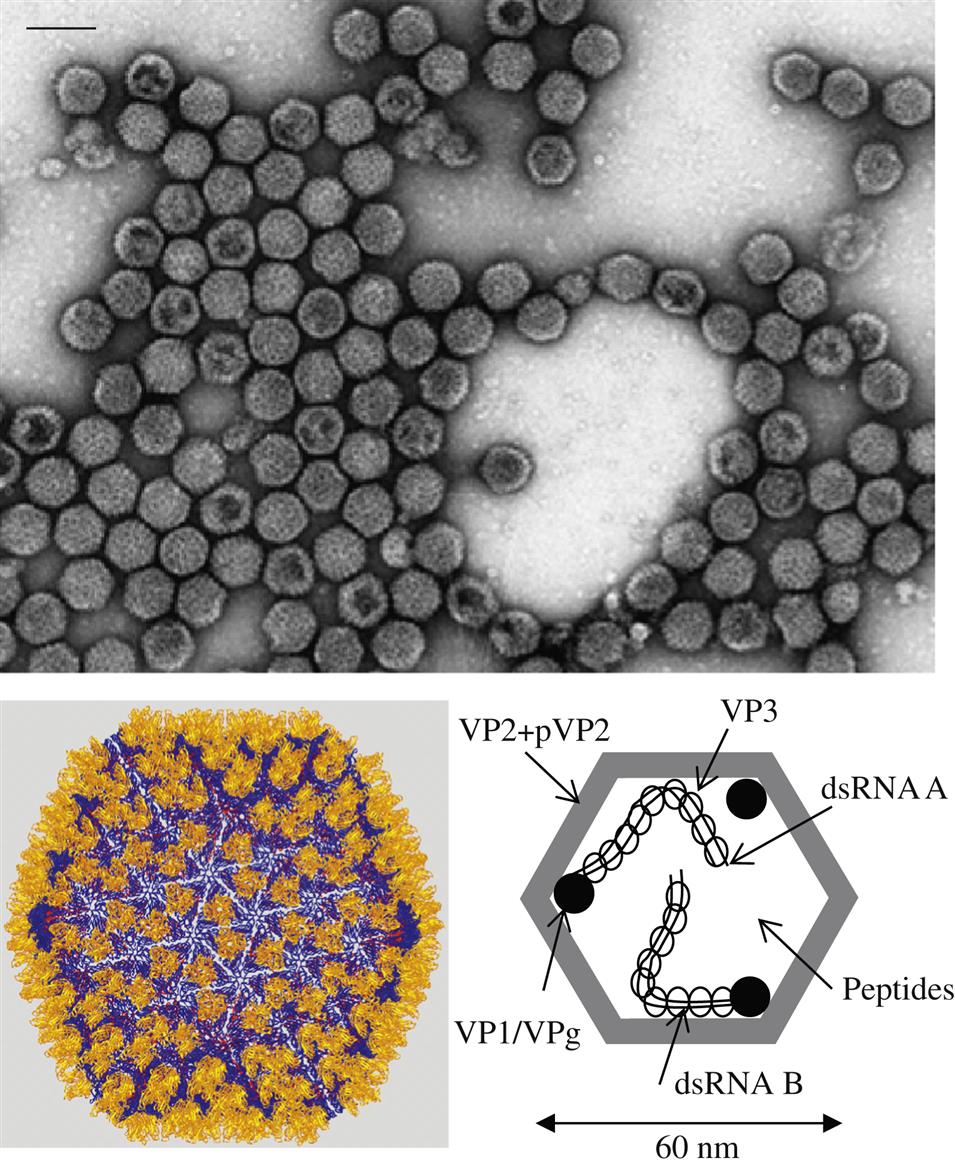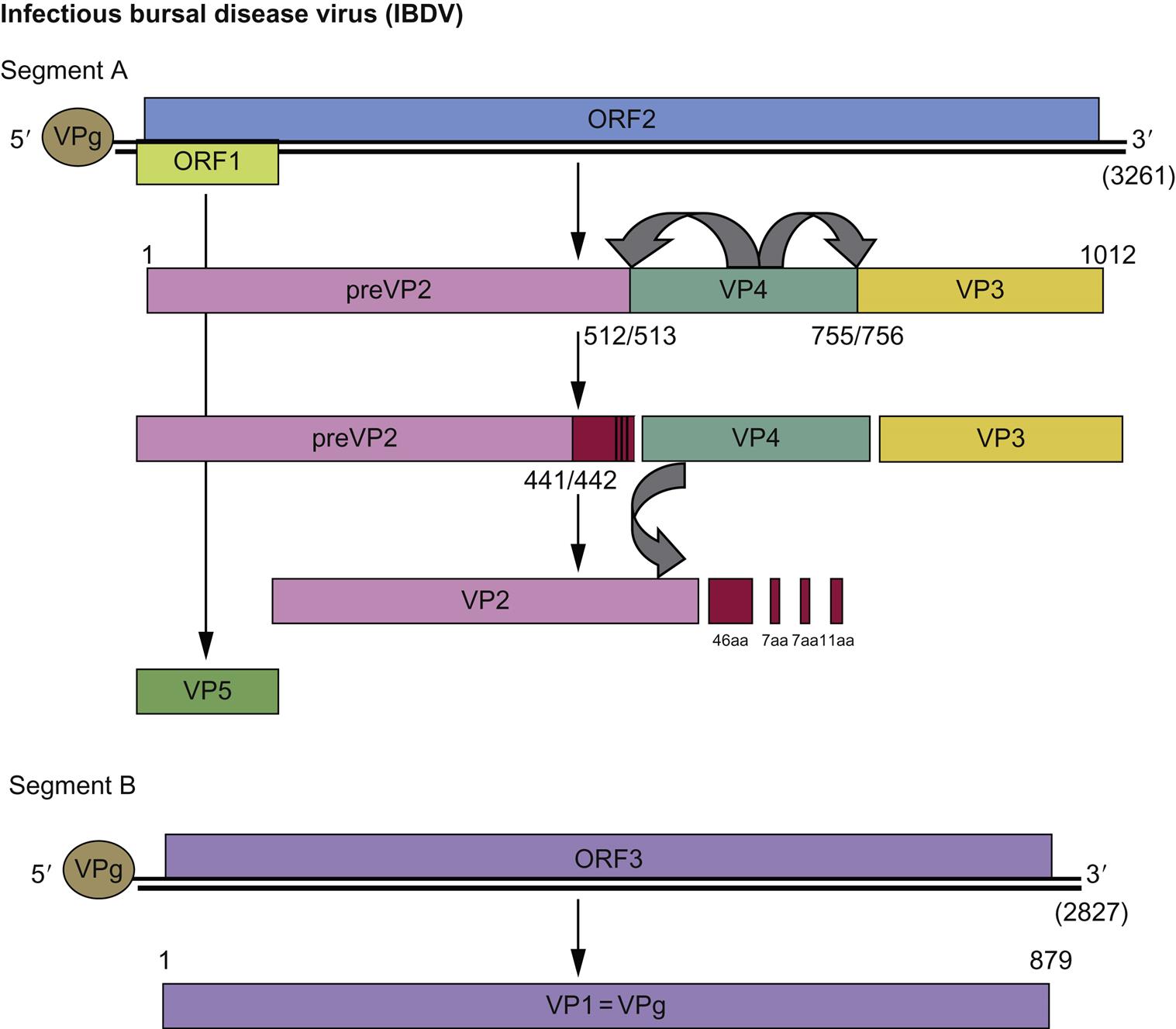Birnaviridae and Picobirnaviridae
Abstract
This chapter describes the properties of birnaviruses and picobirnaviruses and features of the diseases they cause in animals.
Keywords
Birnavirus; picobirnavirus
Viruses in the families Birnaviridae and Picobirnaviridae have nonenveloped, single-shelled virions that include a genome of two linear segments of double-stranded RNA. Two members of the family Birnaviridae are economically significant pathogens, specifically, the etiologic agents of infectious bursal disease of chickens and infectious pancreatic necrosis of fish. The family Picobirnaviridae include viruses that are smaller than true birnaviruses. Birnavirus- and picobirnavirus-like viruses have been detected in the feces of humans and animals with and without diarrhea, including many species of mammals, reptiles, and birds, thus, these apparently ubiquitous agents are potential but largely unproven causes of diarrhea in both humans and animals.
Infectious bursal disease was first recognized in 1962 in an outbreak of disease in chickens in Gumboro, Delaware; further outbreaks were subsequently referred to as “Gumboro disease.” The most prominent lesion of this disease is located in the cloacal bursa (bursa of Fabricius), hence the present name of the disease. Large numbers of virions were observed by electron microscopy in the bursa of infected birds during early investigations of the disease, but these virus particles were initially misidentified as picornaviruses, adenoviruses, or reoviruses. Infectious pancreatic necrosis was first described in 1941 among rainbow trout (Oncorhynchus mykiss) in North America, although the viral etiology was not established until the 1950s. Infectious pancreatic necrosis virus and many strains of closely related aquatic birnaviruses are found worldwide and are responsible for considerable economic losses to both freshwater and marine aquaculture.
Properties of BIRNAVIRUSES and PICOBIRNAVIRUSES
Classification
The family Birnaviridae comprises four genera: Avibirnavirus, Aquabirnavirus, Blosnavirus, and Entomobirnavirus. Infectious bursal disease virus is the sole member of the genus Avibirnavirus. Members of the genus Aquabirnavirus include the type species, infectious pancreatic necrosis virus of salmonid fish, and a number of related viruses associated with infection or disease in a wide variety of fish, mollusks, and crustaceans. Blotched snakehead virus (a virus of fish) is the sole member of the genus Blosnavirus, and is more closely related genetically to the avibirnaviruses rather than the aquabirnaviruses. Members of the genus Entomobirnavirus infect only insects and will not be considered further.
The family Picobirnaviridae includes a single genus Picobirnavirus, members of which have been identified in the feces of humans, rabbits, and a variety of other species of mammals, reptiles, and birds. Picobirnaviruses have been increasingly recognized with the advent of deep sequencing analysis of fecal specimens from many species of animals, and distinct genetic subgroups are now described.
Virion Properties
Birnavirus virions are nonenveloped, approximately 65 nm in diameter, and hexagonal with a single shell having icosahedral symmetry (Fig. 16.1). The genome consists of two unrelated molecules of linear double-stranded RNA, designated A and B (Fig. 16.2). Segment A ranges from 3.1 to 3.6 kbp in size and contains at least two open reading frames, the largest of which encodes a polyprotein that is processed to form the structural proteins, VP2 and VP3, and a viral protease (designated as VP4 or NS, depending on the virus) that autocatalytically cleaves the polyprotein. The functions of the protein products of other open reading frames (eg, VP5) are less characterized. VP2 forms the virus capsid and is responsible for binding the cellular receptor and determining the cellular tropism of the virus. VP2 also contains the principal antigenic sites responsible for eliciting neutralizing antibodies. The inner capsid protein, VP3, contains group-specific antigenic determinants and is associated with the genomic RNA. Segment B is approximately 2.8–3.3 kbp in size and encodes VP1, which is the RNA polymerase. VP1 exists as a genome-linked protein (VPg) that circularizes segments A and B by tightly binding to their ends. Termini of the genome segments resemble those of other segmented RNA viruses, such as reoviruses and influenza viruses, in which both the 5′ and 3′ ends share a high degree of sequence identity between the segments. At both ends of both segments, there are direct terminal and inverted repeats that are predicted to form stem and loop secondary structures and probably contain important signals for replication, transcription, and encapsidation.
Picobirnavirus virions resemble those of the birnaviruses with a single capsid protein shell, but are smaller (33–37 nm) in diameter. The genome of picobirnaviruses is also smaller than that of birnaviruses: specifically, a larger segment of 2.4–2.6 kbp that encodes the capsid protein precursor, and a smaller segment of 1.5–1.9 kbp that encodes the viral RNA-dependent RNA polymerase.
Virions are relatively heat stable, and their infectivity is resistant to exposure at pH 3 and to ether and chloroform.
Virus Replication
Infectious bursal disease virus replicates in both chicken and mammalian cells; however, highly pathogenic strains can be difficult to cultivate. Infectious pancreatic necrosis virus and other aquatic birnaviruses replicate in fish cell lines incubated below 24°C. Both avibirnaviruses and aquabirnaviruses enter susceptible cells by the endocytic pathway, although endosomal acidification is not a prerequisite for virus internalization. Heat-shock protein 90 and α4β2 integrin are proposed to contribute to the putative receptor complex for infectious bursal disease virus on chicken cells. Many early events in the infection cycle, however, remain to be characterized. Birnaviruses replicate in the cytoplasm without greatly depressing cellular RNA or protein synthesis. The viral mRNA is transcribed by a virion-associated RNA-dependent RNA polymerase (transcriptase-VP1). RNA replication is believed to be initiated independently at the ends of the segments and to proceed by strand displacement, with the inverted terminal repeats at the ends of each segment playing a part in replication (Table 16.1).
Table 16.1
Properties of Birnaviruses and Picobirnaviruses
Virions of birnaviruses are nonenveloped, hexagonal in outline, approximately 65 nm in diameter, with a single shell having icosahedral symmetry; picobirnaviruses are smaller (35 nm) viruses with similar appearance
Genome consists of two molecules of linear double-stranded RNA, designated A and B, approximately 6 kbp in overall size for birnaviruses and 4 kbp for picobirnaviruses
A single major capsid protein, and one or more nonstructural proteins (RNA polymerase (transcriptase))
Cytoplasmic replication
Survives at 60°C for 60 min; stable at pH 3 to pH 9
Birnaviruses occur in chickens (infectious bursal disease virus), salmonid fish (infectious pancreatic necrosis virus), and many species of marine fish and shellfish (aquatic birnaviruses) as well as reptiles, crustaceans, and insects. Picobirnaviruses have been detected in feces of humans and a wide variety of other mammals, birds, and reptiles, sometimes in association with diarrhea
Stay updated, free articles. Join our Telegram channel

Full access? Get Clinical Tree




